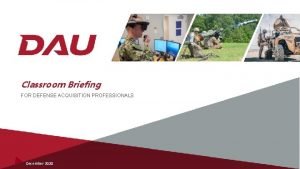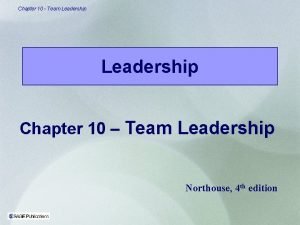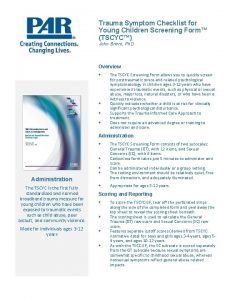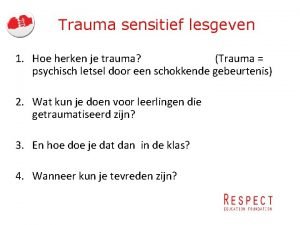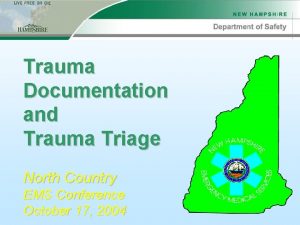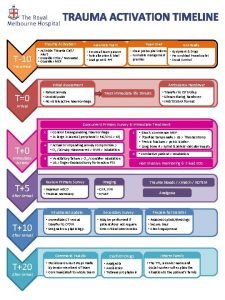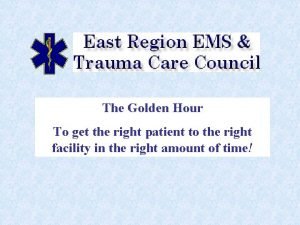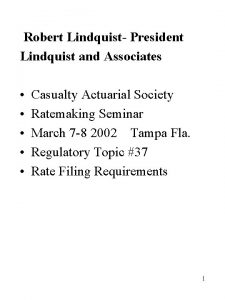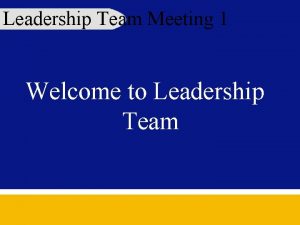Trauma Team Leadership David G Lindquist MD Marc






























- Slides: 30

Trauma Team Leadership David G. Lindquist, MD Marc J. Shapiro, MD

Culture of Safety - Aviation Military Nuclear Energy - High stakes, high risk occupations, requiring real-time decisions with potentially limited information. Error prevention is a key tenet of standard procedures.

Culture of Safety 1979 NASA conference on causes of air transport accidents: Failures of : -Interpersonal communication -Decision making -Leadership

Human Error in Aviation and Medicine 70% commercial aviation accidents due to human error. Helmreich RL. Managing Human Error in Aviation. Sci Am 1997 May; 276(5): 62 -67. “Pilot error accounted for 68% of all fatal aircraft accidents. ” Kumar U. Analysis of fatal human error aircraft accidents in IAF. IJASM 2003; 47(1) 30 -36. 30% “human error. ” Leape et al The nature of adverse events in hospitalized patients. Results of the Harvard Medical Practice Study II New England Journal of Medicine. 324(6): 377 -84, 1991 Feb 7. Types of error similar Communication Decision making Conflict resolution

Clinician Attitudes About Teamwork - Operating Room (Sexton JB et al. BMJ. 320(7237): 745 -9, 2000 Mar 18. ) -Only 55% of consultant surgeons rejected steep hierarchies -Minority of Anesthesia and Nursing reported high levels of teamwork - Critical Care (Thomas EJ et al. Crit Care Med. 2003 Mar; 31(3): 992 -3) -Discrepant attitudes between physician and nurses about teamwork n n 73% physicians “High” or “Very High” 33% nurses “High” or “Very High”

CHANGING ATTITUDES AND BELIEFS Attitudes / Beliefs Old New Human Performance I am perfect Humans are fallible Care Delivery I work alone I work with others Error Origin Individual caregiver failure Teamwork failure Peer Monitoring offends me Monitoring protects me and my patients Skills Requirements Clinical skills & team coordination skills Reproduced with permission (DRC). Emergency Team Coordination Course- Student Guide. Locke A (Ed. ). Andover MA: Dynamics Research Corporation, 1997, p. In-3.

“The Sharp End” - James Reason, 1990 Pilots, Operating Room Staff: -Decision makers -Frontline for large institutions -Supported versus hampered by institutional attitudes toward safety.

Behaviors at the “Sharp End” Helmreich et al. , 1994. Fifty-two accidents/incidents due to human performance were reviewed: - Behavioral Markers: -Captain failing to establish balance between authority and crew participation in decision making. -Failure to establish open communications -No team concept -Lack of contingency planning -Lack of junior crew members’ assertiveness.

Human Limits (Defined by the human genome): - Vision Perception Cognitive Capacity Memory Attention Fatigue External Stressors Interestingly, at very low volume workloads, the error rate also increases.

WORKLOAD COMFORT AND PERFORMANCE High Performance Risk Zone Mod BOREDOM Low COMFORT ZONE Moderate WORK OVERLOAD High Very High Workload Reproduced with permission (DRC). Emergency Team Coordination Course- Student Guide. Locke A (Ed. ). Andover MA: Dynamics Research Corporation, 1997, p 4 -6.

Trauma Team Leadership

Leadership Strategies - Communication - Delegation - Control of Environment - Error Management - Communication

KEY TEAMWORK ACTIONS -Establish the leader -Assemble the team -Designate roles and responsibilities -Communicate essential team information. -Acknowledge the contributions of team members. -Demonstrate mutual respect in all communication. -Hold each other accountable for team outcomes. -Address professional concerns directly. -Resolve conflicts constructively.

Establish Team and Leader - Identify yourself to nursing. - Verbally clarify others’ roles: -Nursing: lines, meds, documentation. -MD’s: Airway, primary/secondary survey, leftsided vs right-sided procedures. -Trauma room staffing levels and rosters are dynamic. Different from the operating room or the TICU, team structure and communication lines must be established each time.

Delegate Tasks Helmreich, 1998: low vs highcomplexity flights: - During high-complexity flights, when the 1 st officer, and not the captain, was piloting the plane, increased leadership and overall crew effectiveness were noted. - Leader must maintain “situational awareness” in order to: -Solicit information for decision-making. -Avoid Cognitive Overload.

Situational Awareness Example: In 1972, an Eastern Airlines Lockheed Tristar approached Miami International Airport. A warning light indicated the landing gear had not deployed properly. The pilot circled, attempting to establish whether the landing gear was in fact deployed. The plane ran out of fuel and crashed during an attempted emergency landing. No one survived. Post-crash analysis revealed the landing gear had deployed. The warning light was faulty.

Control the Room - Assign roles. Delegate tasks. Strategic position to view patient, monitor, and room. - Take on a procedure only if necessary; regain control of room after procedure. - Request information (uphill flow).

Effective Point Communication Give specific orders to a specific person: - Use their name. - Point. - Make eye contact. -Ensures you know they heard you. -Provides opportunity for “check-back. ” -Easier to alter routine (e. g. mannitol 25 g instead of 50 g).

Communication Example: Nursing is accustomed to giving mannitol, 50 g. Surgical resident requests 25 g mannitol and leaves room without confirming order (checkback). Nursing coverage changes, and order is passed along as “patient needs to get mannitol. ” Patient receives 50 g of mannitol and becomes hypotensive. - Issues: -Deviating from routine without clarifying. -No check-back. -Order incorrectly passed to next caregiver.

Effective Communication - Silence unnecessary chatter. - Speak under the noise. - Avoid shouting to the air. -A task assigned will be performed sooner. -If you’re shouting, you’re not in control. -Calm exudes confidence. - Request data.

Patient Exam and Plan - Call out physical findings Ensure room is quiet. (data). - Announce plan to the room (converse of assigning task directly). -Decreases confusion -Increases cooperation -Increases speed and efficiency e. g. “We are going to CT in 5 minutes. ”

EVENT-DRIVEN DECISION MAKING: THE TEAM’S ROLE - Acquire and communicate information rapidly (e. g. , history and physical exam). - Monitor the developing situation, alert others to new information, and report the effects of earlier interventions. - Be alert to changes in courses of action as solution alternatives become better defined. - Provide feedback to the decision maker on the progress of the selected course of action.

The Team’s Responsibility - All team members are expected to notify the team if they perceive an error or a potential error. - Failure to notify the team permits error propagation. - If a team member feels their concern is not adequately addressed, after raising the issue twice, it is not only permissible but expected they will immediately raise the issue with the next level of authority.

Leadership and Error Management “Everyone makes mistakes. Experts recover faster. ” - Avoidance - Trapping - Mitigation - Exacerbation

Five Precepts for Error Management (Helmreich and Meritt, Culture at Work in Aviation and Medicine) - Human Error is inevitable in complex systems. - Cognitive capabilities impose the limitation of human performance. - High workload and stress increase error. - Safety is a universal value but there is a continuum. How much safety we want and what can we afford? - High Risk Organizations must develop a safety culture to make individuals and teams responsible.

Leadership and Error Management - The goal is patient safety. - If the situation has changed, address the situation, not your ego. -Assess problem. -Obtain required information. -Fix problem. -Prevent recurrence.

Error Management - Debrief team member appropriately. -Goal is to minimize effect and prevent recurrence. “Incompetent! Weak!” “If you see X, do Y. ” “Conditions A and B are a setup for Z…” “For this procedure, the experienced surgeon will…” (anticipatory guidance).

Leadership and Error Management - Leadership is a continuum; how you handle an episode now influences later episodes. - Fearful team members may withhold information: -Inhibits error avoidance. -Prevents error trapping. -Prevents error mitigation. -Fosters error exacerbation.

Trauma Room Leadership Summary - Well developed concept in other high performance, high risk industries. Medicine is beginning to acknowledge it. - Communication driven: -Identify and Assign Roles. -Delegate Tasks. -Assign Orders to Individuals. -Request Information (e. g. Phys Exam). -Announce Plan. -Insist on timely error notification. -Manage Error: Clarify, Fix, Prevent.

References 1. Cooper GE, White MD, & Lauber JK (eds) (1979), Resource management on the flightdeck (NASA Conference Publication 2120), Moffett Field, CA: NASA-Ames Research Center. 2. Helmreich RL. Sci Am 1997 May; 276(5): 62 -7. 3. Kumar U. IJASM 2003 47(1). 4. Sexton JB et al. BMJ. 320(7237): 745 -9, 2000 Mar 18. 5. Thomas EJ et al. Crit Care Med. 2003 Mar; 31(3): 992 -3. 6. Reason J. (1990): Human Error. New York, Cambridge University Press. 7. Helmreich RL, Butler RE, Taggart WR & Wilhelm JA (1994), The NASA/University of Texas/FAA Line/LOS Checklist: A behavioral marker-based checklist for CRM skills assessment, NASA/UT/FAA Technical Report 94 -02, revised 12/8/95, Austin, TX: The University of Texas. 8. Helmreich RL and Merritt AC (1998), Culture at Work in Aviation and Medicine. Aldershot, England, Ashgate Publishing Co. 9. Hines WE (1998), ’Teams and Technology: Flightcrew performance in standard and automated aircraft’, unpublished doctoral dissertation at The Univeristy of Texas at Austin.
 David lindquist md
David lindquist md Martin lindquist
Martin lindquist Team spirit becomes team infatuation
Team spirit becomes team infatuation Team spirit becomes team infatuation
Team spirit becomes team infatuation The white team cheers for the blue team, just like
The white team cheers for the blue team, just like Extended leadership team
Extended leadership team Pmt 0170 risk management exam
Pmt 0170 risk management exam Hill's model of leadership
Hill's model of leadership School leadership team roles and responsibilities
School leadership team roles and responsibilities Ginnetts team leadership model
Ginnetts team leadership model Pbis leadership team
Pbis leadership team Transactional leadership and transformational leadership
Transactional leadership and transformational leadership Situational leadership vs adaptive leadership
Situational leadership vs adaptive leadership Adaptive leadership vs situational leadership
Adaptive leadership vs situational leadership Saul vs david leadership
Saul vs david leadership King david leadership style
King david leadership style Vicarious traumatisation
Vicarious traumatisation Trauma gestig behindert
Trauma gestig behindert Macam macam trauma thorax
Macam macam trauma thorax Tscyc screening form
Tscyc screening form Trauma sensitief lesgeven
Trauma sensitief lesgeven Trauma awareness and treatment center utah
Trauma awareness and treatment center utah 4 r's trauma informed care
4 r's trauma informed care Lgbtq trauma informed care
Lgbtq trauma informed care Millers mobility classification
Millers mobility classification Miemss trauma decision tree
Miemss trauma decision tree Examples of little t trauma
Examples of little t trauma Trauma splitting
Trauma splitting Trauma timeline template
Trauma timeline template Dr anita ravi
Dr anita ravi Treasrenee
Treasrenee






